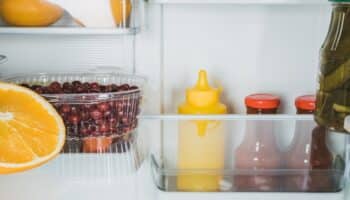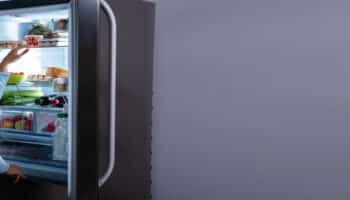We've independently reviewed this article to make sure it's as accurate as we can make it.
To find out more about our article creation and review process, check out our editorial guidelines.
Is your fridge pouring water too slowly, and you’re losing your patience?
That sucks! Getting unlimited water from our fridges is a comfort that we’ve all grown accustomed to, which means that when we can’t, it can be very inconvenient.
I know how annoying it can be to have your fridge fail to do something so simple – especially if you paid good money for it. But don’t worry; you’ve come to the right place for answers.
Below, you’ll find a list including 4 reasons why your fridge is pouring water too slowly, as well as effective solutions you can try to get everything back to normal.
When your fridge is pouring water too slowly, it can be due to an issue with your incoming water supply, a clogged water filter and housing, a damaged water valve, or frozen components.
Read on to get a steady supply of water again!
Why trust us? This article was written by Craig Anderson and Andy Fulenchek.
Craig has helped thousands of other homeowners repair their appliances since 2016.
Andy is one of our resident appliance repair experts with over a decade of experience. He currently runs his appliance repair company with a team of trusted technicians.
Why Your Fridge Is Pouring Water Slowly
In my experience, when a fridge is pouring water slowly, there’s sadly no single answer to the issue, as many components and different elements can be to blame.
However, throughout the years, I’ve learned that out of all the possible causes of the situation, there are some things that should be checked first. Here’s what I recommend you try.
#1 Check Your Incoming Water Supply
The first possible culprit when your fridge is pouring water too slowly is an issue with your water supply. Before considering there’s something wrong with the appliance itself, it’s important to rule out external factors.
There are many reasons why your home’s water supply to the fridge could be partially or entirely restricted – from clogging to more complex and serious problems, such as pinhole leaks or severely broken piping underneath your flooring.
Solution: To determine whether your home’s water supply is to blame for the situation, my usual advice is to turn off the valve located at the back of your refrigerator, then do the following steps:
- While still connected to your home’s water supply inlet at the wall, place the water line inside a bucket.
- Open the water valve again to see how it flows from the wall into the bucket.
Observe carefully for any signs of low water pressure or blockages. Sometimes, the problem is not with the water supply but with the water line, so please check it thoroughly.
Assuming the water line looks fine and free of obstructions and the water supply from the wall is okay and has good pressure, the issue likely lies within the fridge.
#2 Inspect the Water Filter and Housing
The next possible reason why your fridge is pouring water too slowly is a clogged filter or a bad filter housing. Both components play a key role in how water flows from your home’s water supply to your glass at the end of the water-pouring process.
To determine whether the filter or the housing is to blame for the situation, my usual advice is that you check each component separately by bypassing the filter.

Solution: Access the water filter and housing; the process to do so will vary depending on your fridge’s brand and model, so please refer to your User Manual for specific instructions. Provided you don’t have the manual handy, refer to our free resource below.
Once you have clear access to the filter and housing, carefully disconnect the water line from the filter and try dispensing water into a cup. If the flow of water improves, there’s likely a clog in the filter. However, if the water flow is still slow, you’ll also have to replace the housing.
You can typically expect to spend about $100 on a new fridge filter and about $150 on a new filter housing. If you hire a professional to handle the repair, you’ll likely be looking at a $250-$300 total cost.
#3 Check the Water Valves
A faulty water valve can also explain why your fridge is pouring water too slowly.
Sometimes, valves inside refrigerators are not open all the way, which can restrict the free flow of water and explain the situation you’re currently in. Depending on the fridge model you own, your appliance might have more than one valve inside.
For example, I’ve found that some fridge models have a primary valve before the ice maker and then a couple more independent valves for the ice maker, which can make pinpointing the problem a little harder.
Solution: To start solving the issue, you’ll have to first determine if water is restricted before or after reaching the primary valve. If you’ve already followed the 2 steps above, you have a good headstart, as you know that neither your water supply inlet nor the filter or its housing is to blame.
If your fridge has a diagnostic mode, run it (check your User Manual for the specific steps for your model). The diagnostic mode in most fridges will send power independently to every valve to test them for any signs of failure.
Assuming the diagnostics tool determines that one or more valves are failing, my usual advice is to replace the faulty valve. Depending on how confident you are in intermediate DIYs, you can try to do the replacement yourself or reach out to a professional.
#4 Check for Frozen Components
Lastly, let’s consider one more possibility that can explain why your fridge is pairing water too slowly – frozen components.
If the temperature inside your fridge is set too low, the water reservoir behind the crisper tray or the dispenser on the door can freeze. A clear sign of a frozen component is a complete stop to the water flow from the fridge.
Solution: Check your fridge settings and ensure the compartment is not too cold, as that can freeze the reservoir.
If you suspect a frozen component is to blame for your current situation, I recommend you get a couple of ice bags and a cooler to place your groceries and frozen goods inside. Once your food is safe from spoilage, unplug your fridge from the wall outlet and let it defrost for about a day or so.
After 24 hours, any ice blockages will have melted. Ensure you adjust your fridge settings to prevent freezing in the future and guarantee optimal appliance results and efficiency. Typically, your fridge’s manufacturer will have included their recommended settings in the product’s User Manual.
Preventive Measures
Now that you’ve checked and addressed the main causes behind your fridge pouring water too slowly, let’s go through a quick recap of some preventive measures and good practices you can implement to prevent issues in the future.
- Regularly check and replace your fridge’s water filters: Frequent checkups can prevent clogging and reduce the chances of slow water flow.
- Hire a professional if things get too complex: Some repairs will require a certified technician’s skill set and tools. Attempting such repairs on your own can be dangerous to you and result in further damage that will be more expensive to repair down the line.
Restoring Regular Water Flow in Your Fridge
That about sums it up!
When your fridge is pouring water too slowly, something as simple as getting a fresh glass of water can be annoying.
Luckily, as I hope this piece has helped you better understand, addressing the most common causes behind a fridge that’s pouring water too slowly can be easy and quick. More often than not, simple actions, such as checking the fridge’s water filter and housing for clogs, and ensuring the water supply in your home has good flow and pressure, will do the trick.
Thanks for reading. If this article was useful and answered your most burning questions, please check out our other resources and free guides below and consider subscribing to our newsletter.
Have a wonderful week!
-Craig.









